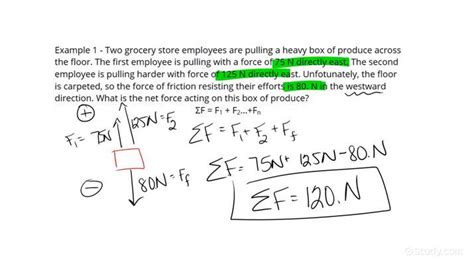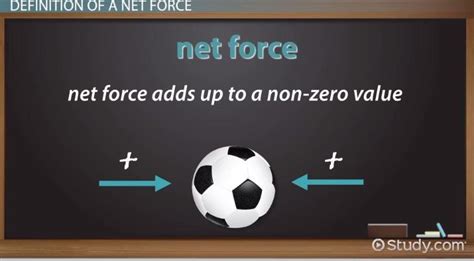Understanding the concept of net force is crucial in physics, as it helps in predicting the motion of objects. The net force, also known as the resultant force, is the vector sum of all forces acting on an object. Solving for net force involves identifying all the forces acting on an object, determining their magnitude and direction, and then calculating the resultant force. This process is essential in various fields, including engineering, mechanics, and physics.
Identifying Forces Acting on an Object

To solve for net force, the first step is to identify all the forces acting on the object. These forces can be external, such as friction, gravity, or applied forces, or internal, although internal forces typically cancel each other out. For each force, it’s essential to determine its magnitude (how strong the force is) and its direction. Forces can be represented by vectors, which have both magnitude and direction. Common forces to consider include the force of gravity (weight), normal force, frictional force, and any applied forces.
Calculating the Net Force
Once all the forces acting on an object are identified, the next step is to calculate the net force. This is done by adding all the forces vectorially. Since forces are vectors, their directions must be considered when adding them. Forces acting in the same direction are added together, while forces acting in opposite directions are subtracted. The formula for net force (F_net) is the sum of all forces acting on an object: F_net = F1 + F2 +… + Fn, where F1, F2,…, Fn are the individual forces. If forces are given in terms of their components (e.g., x and y components in a 2D plane), the net force in each direction can be calculated separately and then combined using the Pythagorean theorem to find the magnitude and direction of the net force.
| Force Type | Direction | Magnitude |
|---|---|---|
| Gravity (Weight) | Downwards | mg (mass * acceleration due to gravity) |
| Normal Force | Perpendicular to surface | Varies, equal to weight on a horizontal surface |
| Frictional Force | Opposite to motion | Depends on the surface and the force applied |

Applying Newton’s Laws of Motion

Newton’s laws of motion provide a fundamental framework for understanding how forces affect the motion of objects. The first law (Law of Inertia) states that an object at rest stays at rest, and an object in motion stays in motion with the same speed and in the same direction unless acted upon by an unbalanced force. The second law relates the net force acting on an object to its mass and acceleration (F_net = ma), providing a direct way to calculate the net force if the mass and acceleration of the object are known. The third law states that for every action, there is an equal and opposite reaction, which is useful in identifying forces acting on objects.
Real-World Applications
Solving for net force has numerous real-world applications. In engineering, understanding net forces is critical for designing structures, bridges, and buildings that can withstand various external forces such as wind, gravity, and earthquakes. In mechanics, calculating net forces helps in understanding the performance of vehicles and machines, ensuring they operate efficiently and safely. In sports and physical activities, understanding how to manipulate net forces can improve performance and reduce the risk of injury.
Key Points
- Identify all forces acting on an object, including external forces like gravity, friction, and applied forces.
- Calculate the net force by adding forces vectorially, considering both magnitude and direction.
- Apply Newton's laws of motion to relate net force to mass, acceleration, and the motion of objects.
- Real-world applications include structural design, mechanical engineering, and optimizing physical performance in sports.
- Understanding net force is essential for predicting the motion of objects and ensuring safety and efficiency in various fields.
Calculating Net Force in Practice
In practice, calculating the net force involves careful consideration of all forces acting on an object and applying the principles of vector addition. This can be illustrated with a simple example: an object of mass 10 kg is placed on a horizontal surface. If the coefficient of friction between the object and the surface is 0.2, and a force of 50 N is applied horizontally to the object, what is the net force acting on the object? First, calculate the weight of the object (10 kg * 9.8 m/s^2 = 98 N), which is balanced by the normal force. The frictional force opposing the motion is given by the formula F_f = μ * N, where μ is the coefficient of friction and N is the normal force. Since the normal force equals the weight (98 N), F_f = 0.2 * 98 N = 19.6 N. The net force acting on the object is then the applied force minus the frictional force: F_net = 50 N - 19.6 N = 30.4 N.
What is the primary step in solving for net force?
+The primary step is to identify all forces acting on an object, including their magnitude and direction.
How do Newton's laws of motion relate to net force?
+Newton's second law directly relates net force to the mass and acceleration of an object (F_net = ma), providing a method to calculate net force if mass and acceleration are known.
What are some real-world applications of solving for net force?
+Real-world applications include designing structures and machines, optimizing vehicle performance, and improving physical performance in sports.
In conclusion, solving for net force is a fundamental skill in physics and engineering, requiring the identification of all forces acting on an object, calculation of their vector sum, and application of Newton’s laws of motion. By mastering this skill, individuals can better understand and predict the motion of objects, leading to advancements in various fields and improved safety and efficiency in real-world applications.

